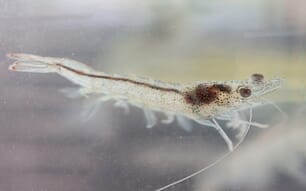Fish and other aquatic animals make an ‘irreplaceable’ contribution to food and nutrition security in many Asian and African countries where large numbers of people are poor and undernourished (Kent, 1987). Fish are a rich source of high quality protein, a range of micronutrients, and fatty acids essential for human brain development (Tacon and Metian, 2013). They are also often the cheapest and most frequently consumed animal-source food in low income food deficit countries (World Bank, 2006), making an important contribution to diversity in otherwise monotonous diets dominated by starchy staples (Thilsted, 2013). Fish make a further contribution to food and nutrition security above that of their intrinsic nutrient content because the consumption of animal-source food facilitates uptake of nutrients from dietary components of vegetable origin (Leroy and Frongillo, 2007). This role is particularly important in countries such as Bangladesh, Cambodia, Ghana, Nigeria, and the Pacific islands, where many people are impoverished and fish is by far the most frequently consumed animal-source food (Belton et al., 2011, Hortle, 2007, Biederlack and Rivers, 2009, Gomna and Rana, 2007 and Bell et al., 2009).
Aquaculture, simply defined, is the farming of fish and other aquatic organisms, with ‘farming’ implying (a) some form of intervention to increase yields, and (b) some form of private ownership of the stock subject to intervention (Beveridge and Little, 2002). In contrast, the fish stocks targeted by capture fisheries remain as a common property until harvested. At the aggregate global level, capture fisheries output has stagnated since the late 1980s, and 80% of 523 world fish stocks for which assessment data are available are reported as fully or over-exploited (Muir, 2013). This is an outcome of what Pauly (1990, p3) has labeled ‘Malthusian overfishing’, whereby fisheries, ‘can generate in the long term at best a steady yield, or a yield oscillating more or less strongly around some mean value, once the rush following resource development is over’ [italics in original]. Aquaculture has grown faster than all other major food sectors since 1980, at 8.8%/year ( FAO, 2013a). Average annual intakes of fish reached a record level of 18.6 kg per capita in 2011 as a result ( FAO, 2012a). It is predicted that the proportion of food fish derived from aquaculture will exceed that from capture fisheries by 2018 ( FAO, 2012a) and that by 2030 aquaculture will provide 16 million and 47 million additional tonnes of fish ( Hall et al., 2011); an increase of 26–76% over the current output of 62 million tonnes ( FAO, 2013a). The primary driver of this growth will be demand from an increasingly wealthy, urban global middleclass ( Garcia and Rosenberg, 2010).
These trends have resulted in policy narratives which position capture fisheries as ‘doomed’, or subject to ‘inevitable decline’ (Friend et al., 2009), and emphasize that ‘any increase in demand for fish can only be met by aquaculture’ (Hall et al., 2011, p52). Thus, aquaculture is frequently presented as a ‘modern’ activity in official development discourses, while there is a tendency for fisheries – particularly small-scale – to be positioned as ‘backward’, or disregarded entirely (Bush, 2008).
Although a fundamental structural transition in the provisioning of fish for food is currently underway, this blanket assessment obscures a great deal of heterogeneity between, and even within, countries. Moreover, although crude increases in average fish intake per capita have occurred in many locations, it does not automatically follow that increased availability of fish from aquaculture equates to better access to fish by poor consumers (Allison, 2011). Evidence also suggests that large farmed freshwater fish often possess micronutrient and lipid profiles inferior to those of small species derived from marine and inland capture fisheries (Roos et al., 2007 and Tacon and Metian, 2013). The implications of the capture fisheries – aquaculture transition therefore remain poorly understood in respect to food and nutrition security.
The remainder of the paper addresses ways in which capture fisheries, aquaculture, and the interactions between them, contribute to or detract from food and nutrition security. Macrolevel changes in the sectoral composition of fish production and consumption are presented for ten countries in the global South. The implications for food and nutrition security at a range of scales are then explored in detail, with reference to livelihoods, product diversity and cultural significance, nutritional quality, prices and ecological trade-offs between capture fisheries and aquaculture.
The global transition in fish supply
The following section reviews capture fisheries and aquaculture output and fish consumption in ten major fish producing countries; eight Asian, two African. These were selected for comparison based on their status as low or middle income countries and major producers and consumers of capture fisheries and aquaculture products. Together, they account for 50% of global population, 55% of the world’s malnourished people and 60% of all fish production (UNDESA, 2011, FAO, 2012b and FAO, 2013a).
Fish production and consumption in all ten countries is summarized in Table 1. Together, these account for 86% of global aquaculture production, while the two African nations alone contribute 86% of African aquaculture output. However, in only two countries (China and Egypt), is aquaculture’s share of production substantially greater than that of capture fisheries. Capture fisheries are two to four times larger than aquaculture in five countries, and of similar size in three. China dominates both capture fisheries and aquaculture production; by almost an order of magnitude more than the second largest producer (India) in the case of latter.
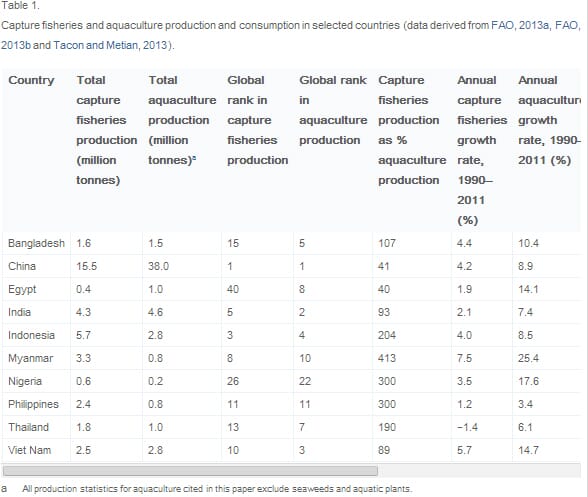
Capture fisheries grew at an average rate of 1–4% per annum in seven countries over the period 1990–2011, with net negative growth in a single country (Thailand). Aquaculture grew between two and seven times faster than capture fisheries in all ten countries, exceeding an annual growth rate of 10% in five, and achieving 6–9% growth in a further four. Average annual fish consumption per capita varies widely, from a low of 5.4 kg in India (where, for cultural and religious reasons, many states do not have a strong tradition of fish consumption), to a maximum of 50 kg in Myanmar. Consumption in all but Nigeria, Egypt and India is considerably in excess of, or very close to, the global average of 18.6 kg (FAO, 2012a). Fish constitutes between 25% and 45% of animal-source food (including meat, milk, eggs and animal fats) in eight countries, and a slightly higher proportion of animal-source protein, indicating its importance to food security.
Despite the clear tendency for aquaculture growth to outstrip that of capture fisheries, this summary highlights the continued dominance of capture fisheries in most countries in terms of total quantities of fish produced, as well as considerable heterogeneity in the size and relative importance of the two sectors. The extent and form of this variation is apparent from Fig. 1a–l. The mismatch between trends in supply and consumption which is evident in many of the figures occurs because around a quarter of capture fisheries production is diverted for non-food uses (FAO, 2012a), and large volumes are traded, particularly from South to North (Smith et al., 2010).
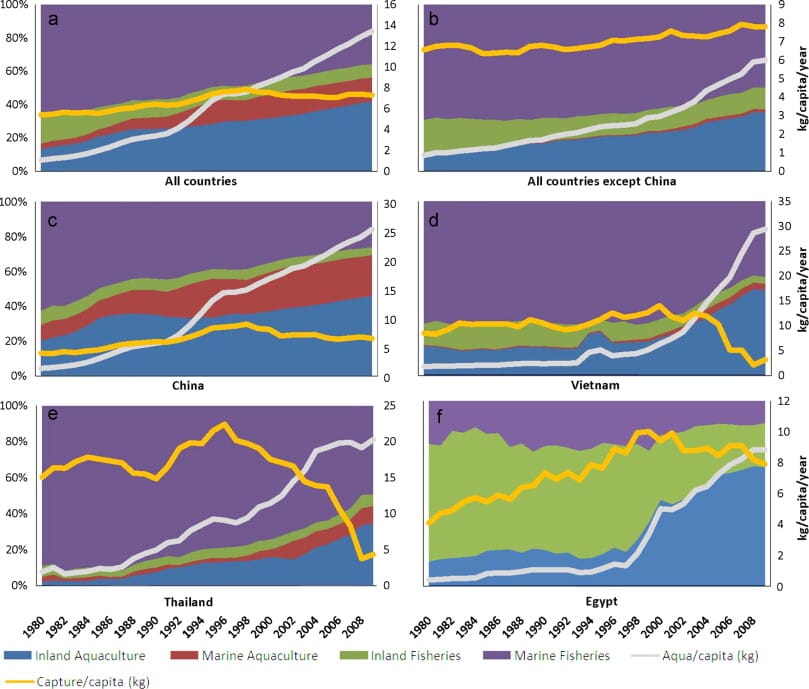
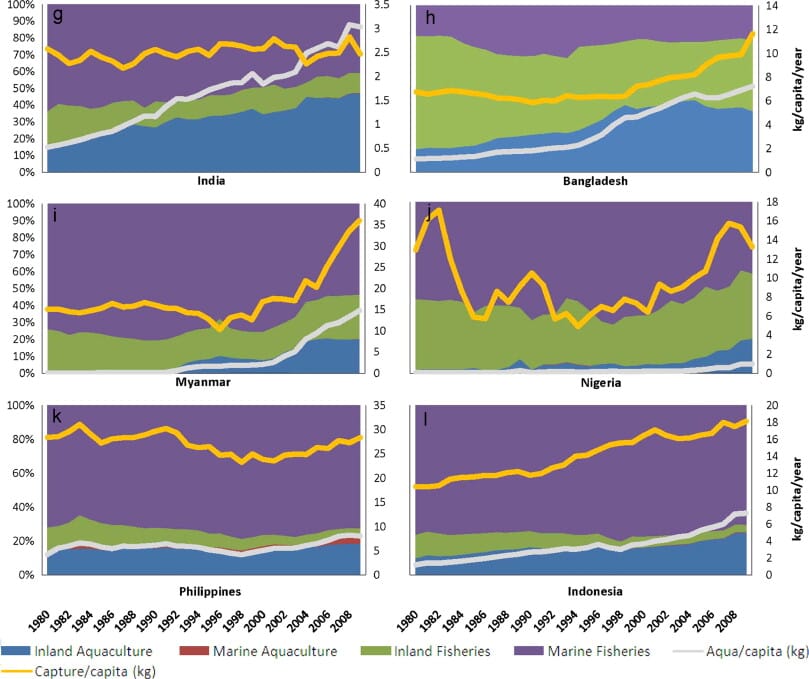
Fig. 1a presents aggregate data for all ten countries. Capture fisheries’ share of total production declined from more than 80% in 1980 to just below 50% in 2009. Its contribution to annual per capita fish consumption remained at 5.5–7 kg over this period, while consumption from aquaculture grew from 1 kg to more than 13 kg. However, Fig. 1b, which omits data from China, reveals the degree to which its inclusion distorts the aggregate picture. Aggregate supply and consumption of fish in these nine countries were dominated by capture fisheries throughout the entire period, despite aquaculture’s contribution to consumption more than doubling from 2000 to 2009.
Data on all ten individual countries are presented in Fig. 1c–l. These are among the most advanced aquaculture producing nations in the world. While the trend for aquaculture growth to outpace that of capture fisheries is clear in all cases, the rate and profundity of the transition is highly variable. This reflects the interaction of a number of factors including the status of natural resource bases, economic development and technical capacities, and their relationship with the length of time elapsed since the ‘take off’ of aquaculture. In most countries outside this ‘elite’ group, including many of those most highly dependent on fish to meet the nutritional requirements of their populations (i.e. much of Sub-Saharan Africa and the Pacific islands), capture fisheries contributions to food and nutrition security remain far more significant than those of aquaculture (Hall et al., 2013).
Implications for food and nutrition security
Livelihoods
Capture fisheries contribute to food security in two ways: ?(i) directly as a source of essential nutrients; (ii) indirectly as a source of income to buy food? (Garcia and Rosenberg, 2010, p2872). Aquaculture can also promote food security via income and employment linkages as well as consumption (Ahmed and Lorica, 2002). FAO (2012a) estimates that 54.8 million people are engaged in the primary sector of capture fisheries and aquaculture. Of these, around 38.2 million (70%) are in capture fisheries. When the multiplier effect of employment in value chains is considered, the total number of people deriving part of their livelihoods from related activities could be several times higher (FAO, 2012a). Weeratunge et al. (2011, p405) suggest that, contrary to the long held notion that fisheries is a male domain, ‘if gleaning and post-harvesting activities were enumerated, the fisheries and aquaculture sector might well turn out to be [a] female sphere’.
Given the large numbers of people involved in the two sectors, livelihoods – food security linkages are significant. This is particularly so in the case of small-scale fisheries, which often have relatively limited entry requirements due to their common pool nature. Small-scale fisheries can act as a ‘safety net’ because of their capacity to provide labor opportunities and incomes to resource-poor households with few other options, reducing, vulnerability and food insecurity associated with both transitory and structural poverty (Béné et al., 2010).
Scope for aquaculture to fulfill the same function is more limited, given the necessity to secure access to land and the often significant investment costs which even fairly small-scale forms of the activity entail. However, evidence suggests that employment in support services to ‘quasi-capitalist’ or capitalist forms of aquaculture can also offer significant employment opportunities for the poor, in some contexts (Belton et al., 2012). Even in its small-scale or ‘quasi-peasant’ forms, aquaculture typically offers high returns in comparison to alternative agricultural activities, with the incomes generated often used to smooth seasonal cash shortages (Belton et al., 2012). In this respect, fish harvested from both capture fisheries and aquaculture may function as a ‘bank in the water’ (Béné et al., 2009).
However, although livelihood opportunities associated with capture fisheries and aquaculture contribute to the food security of large numbers of poor women and men, the direct effects of consuming fisheries products are of even greater significance. We turn to these in the following sub-sections.
Diversity, nutritional quality and utilization
Marine and freshwater catches are dominated by a great diversity of small species (e.g. Thilsted, 2013 and Tokeshi et al., 2012). In contrast, aquaculture is characterized by production of a limited number of large freshwater fish species, most of which reach sizes of 1 kg or more. This has important implications for the nutritional composition of the fish produced by each sector, as well as for its accessibility and utilization.
As Allison (2011, p7) notes, ‘although fish is usually linked to food security concerns through analysis of its contributions to protein supply, it is much more important as a source of micronutrients and lipids’. Two billion people, particularly in the global South, are affected by deficiencies in micronutrients, especially vitamin A, iron and zinc, which damage optimal health and functioning, and greatly affect quality of life (Tulchinsky, 2010).
Table 2 and Table 3 present data on the micronutrient and lipid profiles of a variety of fishes originating from inland and marine capture fisheries and aquaculture. Vitamin A content in the farmed fish for which data is presented is low in comparison to that of species from capture fisheries. Zinc and iron content vary from species to species, but are particularly high in certain fish from inland capture fisheries. Calcium content is similar across all the fish in the tables. However, many fish from inland capture fisheries are small enough to be eaten whole, including bones, meaning that most of their calcium is consumed, whereas virtually all bones, and calcium, from larger fish are discarded as plate waste (Thilsted, 2012a and Roos et al., 2007).
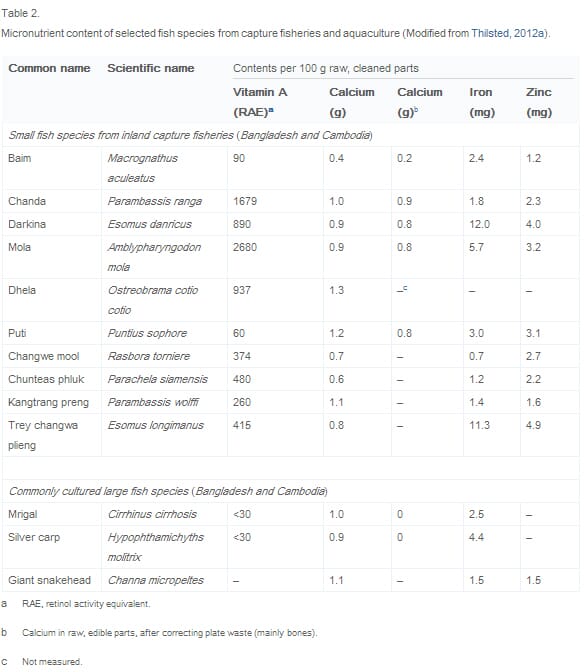
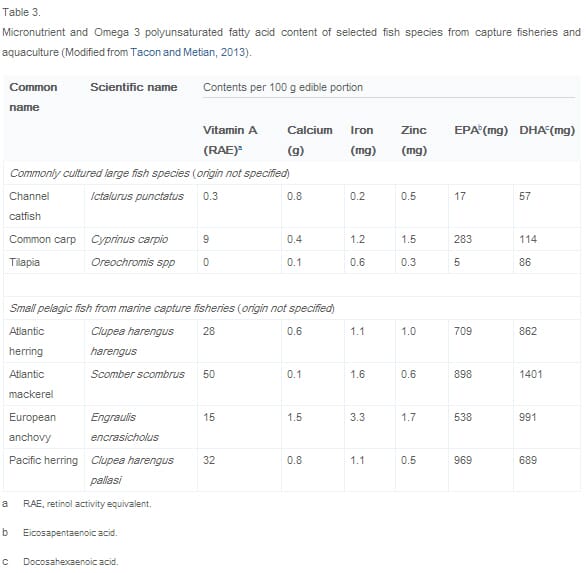
Omega 3 polyunsaturated fatty acids (n-3 PUFAs) are particularly important for human health because they are required for fetal and infant growth, maturation and cognitive development ( Michaelsen et al., 2011). As Table 3 indicates, some small pelagic marine fish possess much higher levels of the n-3 PUFAs EPA and DHA than farmed freshwater fishes. Data on the PUFA content of smaller fish species from inland capture fisheries is currently limited, although Karapanagiotidis et al. (2010) have identified several species of fish and aquatic animals harvested from rice fields in Northeast Thailand as containing considerable levels of total n-3 PUFA.
Tacon and Metian (2013) report that PUFA levels in wild channel catfish are considerably higher than those in their farmed counterparts, and it has been reported that wild tilapia possess more favorable ratios of n-3 to n-6 PUFAs than those fed formulated diets ( Karapanagiotidis et al., 2006). In toto, this suggests a tendency for the nutritional value of small fish from capture fisheries to be higher than that of large intensively farmed freshwater fish.
Whether and to what degree this has substantive implications for food and nutrition security is likely to depend on the extent to which diets are diversified and individuals rely on fish as a major food source. Thus, in a context such as rural Bangladesh, where the poorest are most heavily dependent on small fish from capture fisheries and consumption of other animal-source and nutrient-rich foods is infrequent and limited, a transition in fish supply from capture fisheries to aquaculture might have significant implications for nutrition (Belton et al., 2013). In contrast, for urban dwellers in middle income countries such as China or Thailand, such shifts may be of limited importance given greater access to and consumption of animal products, vegetables and fruits (Pingali, 2006).
Present definitions of food security include social dimensions, including the ability to meet culturally determined food preferences (CFS, 2012). Extremely high species diversity is found in many tropical and sub-tropical marine fisheries (e.g. Tokeshi et al., 2012) and inland fisheries, such as those of the lower Mekong River basin, where ‘hundreds of wild fish species are caught, as well as a wide range of other aquatic animals, including shrimps, crabs, molluscs, insects, snakes and turtles’ (Hortle, 2007, p1). Cultural preferences for the consumption of diverse indigenous fish species originating from capture fisheries, exist in many places (Belton and Bush, 2013).
Throughout South and Southeast Asia and much of Africa, small, low market value fish from capture fisheries are preserved by drying, smoking, fermenting or salting (Hossain et al., 2013, Hortle, 2007 and Mafimisebi, 2012). Preserved fish products are reported to account for one third of fish consumption in Laos, Cambodia, Northeast Thailand and the Mekong Delta provinces of Viet Nam (Hortle, 2007), while dried fish is most frequently consumed type of fish in Nigeria (Gomna and Rana, 2007) and parts of Bangladesh (Hossain et al., 2013). The ability to store and transport preserved fish products makes them accessible to consumers in arid or mountainous areas where little or no fresh fish is available, as well as smoothing seasonal peaks and troughs in supply in producing areas. Preservation can also radically alter fishes’ intrinsic qualities, transforming them into essential ingredients in local cuisines (e.g. fish sauce, fish paste and fermented fish). By fulfilling cultural dimensions of food security in ways that aquaculture cannot (Deb and Haque, 2010), the consumption of preferred indigenous fish species from capture fisheries, and the products derived from them, may contribute to both subjective and material aspects of social wellbeing (Weeratunge et al., 2013).
Another reason why preserved fishes are so frequently and widely consumed is that, unlike the large individual fish produced by aquaculture, they are often sold in small, divisible portions, placing them within reach of low income consumers (Hossain et al., 2013). This principle also applies to small fresh fish from capture fisheries which, in contrast to larger fishes or other animal-source foods, are often sold in small portions at low nominal prices, making them relatively accessible to buyers with very limited incomes (Deb and Haque, 2010 and Kawarazuka and Béné, 2011). Dishes prepared from small fish and vegetables may also be shared more equitably intra-household than those made with large fish (Thilsted, 2012b). The ‘divisibility principle’ can mean that even where the unit value of small fish originating from capture fisheries is higher than that of large fish supplied by aquaculture, the former are often still more accessible to low income consumers (Belton et al., 2013).
Prices
Although size and divisibility make capture fisheries products more accessible than those from aquaculture in some contexts, it is important to consider broader effects that prices play in mediating consumer access to fish. Tveterås et al. (2012) report that after the turn of the millennium, as food prices spiked to record highs, fish prices grew at a comparatively moderate pace. They were also approximately half as volatile as those of cereals, dairy, and oils during this period, and became more competitive relative to meat. The authors attribute this pattern to the increasing supply of fish from aquaculture, which kept pace with demand as a consequence of innovations that reduced production costs (Tveterås et al., 2012).
The authors cite the case of salmon as an example of this tendency, noting that technological changes have driven down the relative price of salmon and dramatically expanded the salmon market (Tveterås et al., 2012). Kumar et al. (2005, p181) reach similar conclusions for India, stating that, ‘technological development [in Indian aquaculture] has lowered the production cost (at constant prices) per unit of fish and made available additional fish at cheaper prices to the consumers and improved their nutritional security’. The availability of this more cheaply priced fish has also induced fish demand (Kumar et al., 2005).
Because aggregate capture fisheries output growth is static, demand increases should raise the price fish harvested from them. However, Tveterås et al. (2012, p7) report that although this has happened to a limited degree since 2000, ‘substitution will dampen price pressure as the demand spills over to farmed fish’. As a result, significant divergence in capture fisheries and farmed fish prices is unlikely. This effect is pronounced for salmon (Knapp et al., 2007) and shrimp (Marks, 2012), but also occurs among capture fisheries and aquaculture products for which the degree of substitution is less perfect.
These findings have profound implications for food security in markets where significant quantities of farmed fish are available because they indicate that (1), expansion of aquaculture has caused the price of farmed fish to grow more slowly than that of all other foods, including meat, and (2) this growth has also reigned in increases in the price of fish from capture fisheries. The two sectors therefore have highly complementary roles to play in ensuring that fish becomes, or remains, available and accessible to poor consumers.
Competition for resources
Capture fisheries and aquaculture can also complete with one another in relation to food security. Trade-offs between them pertain primarily to (1) habitats, (2) access, and (3) fish utilization. Enclosure and removal of mangroves for tropical shrimp production have impacted food security by destroying important nursery grounds for juvenile fish and excluding communities from access to mangrove products (Kelly, 1996). Shrimp aquaculture can also negatively impact food security by causing salinization in rice growing areas (Rahman et al., 2006). However, the worst impacts that occurred during the early stages of shrimp aquaculture are associated with a very specific form of ‘boom crop’ development. Conflicts relating to exclusion and habitat destruction are a less common feature of fish culture in ponds constructed on privately owned agricultural land (Belton and Bush, 2013).
The food security implications of using non-farmed fish as ingredients in aquaculture feeds are much less localized, and larger in scale. One quarter of all fisheries catch is destined for non-food uses. Approximately 60% of ‘non-food’ fish comes from ‘reduction fisheries’ – single species fisheries targeting ‘forage fish’ for conversion to fish meal and fish oil. Aquaculture currently utilizes 68% and 88% of fish meal and fish oil, and its share of total consumption has grown rapidly (Tacon and Metian, 2008). A further 40% of non-food fish landings are comprised of mixed low market value fish and other aquatic animals, sometimes referred to as ‘trash fish’. A substantial proportion is comprised of the juveniles of commercially important species. ‘Trash fish’, which is often landed as bycatch from trawl fisheries, is thought to account for 35% of marine catch in Bangladesh, China, India, Philippines, Thailand and Viet Nam, and is mainly used in farm-made fish feeds (Tacon and Metian, 2009).
Aquaculture’s share of fish meal and oil utilization is growing due to increasing use of compound feeds, resulting in the reallocation of non-food fish away from use in livestock feeds (Tacon and Metian, 2008). However, rising fish meal and fish oil prices have also led to steady declines in average inclusion levels in compound fish feeds, and significant improvements in the ratio of capture fish inputs to farmed fish outputs. As a result of these greater efficiencies, use of fish meal and fish oil in aquaculture is actually projected to fall considerably in real terms by 2020 (Tacon and Metian, 2008). Aquaculture is also a producer of fish meal and oil, with processing waste increasingly utilized for this purpose (Newton et al., 2012).
Although the proportion of global catch diverted to non-food uses has begun to contract recently, indicating increasing competition between food and non-food uses of forage fish (FAO, 2012a), it is questionable whether sufficient latent demand exists to support reallocation of a substantial portion of the total catch to forage fish to direct human consumption. The use of ‘trash fish’ in fish feeds may be more likely to impact food security, because, in addition to contributing to the indiscriminate removal of juvenile food fish, the sale of trawl bycatch may subsidize overexploitation of fish stocks (Funge-Smith et al., 2005). In addition, farm-made feeds are converted to body mass less efficiently than formulated feeds, meaning that the quantity of forage fish required to produce one unit of farmed fish may be several times lower than the quantity of ‘trash fish’ (Hasan, 2012).
Conclusion
Global fish supply is undergoing a fundamental transition as capture fisheries is succeeded by aquaculture. This transition is far from uniform however. Even among major aquaculture producing nations, such as those surveyed in Section 2 of this paper, capture fisheries are crucial to food and nutrition security. For numerous countries outside this ‘elite’ group ‘wild capture fisheries remain the dominant supplier’ (Hall et al., 2013, p1).
In the main, capture fisheries and aquaculture play complementary roles in relation to food and nutrition security. Fish from capture fisheries are a key source of essential micronutrients for many poor consumers. For the better-off, who consume more diverse diets, the distinction between capture and farmed fish is of much lesser importance for nutrition.
Capture fisheries, particularly small-scale ones, provide a vast diversity of culturally preferred, highly nutritious fresh and processed fish which are often accessible to poor consumers due to their ‘divisibility’. Small-scale capture fisheries also generate the vast majority of livelihood opportunities associated with fisheries as a whole. At the same time, the growth of aquaculture has held down fish prices, so that they are far less affected by price volatility than terrestrial foods. Aquaculture has also helped to peg down price inflation for all fish, perhaps reducing the level of exploitation to which capture fisheries stocks would have been subjected if their market value had risen further.
Given the finite and pressured status of global fish stocks, more effective governance at multiple scales is required to ensure that the large numbers of poor people who rely on capture fisheries for livelihoods, food and nutrition can continue to enjoy the right do so. For aquaculture, enormous scope remains to achieve gains in technical efficiency and output. Whilst there is potential for this to reduce dependency on capture fisheries resources and provide a degree of insulation against future price instability, policies should seek to ensure that these processes result in equitable modes of development that do not marginalize smaller producers. Policies which recognize and safeguard the diversity and complementarity of roles played by capture fisheries and aquaculture are essential for ensuring that the transition in global fisheries sustainably improves food and nutrition security in the South.
April 2014



